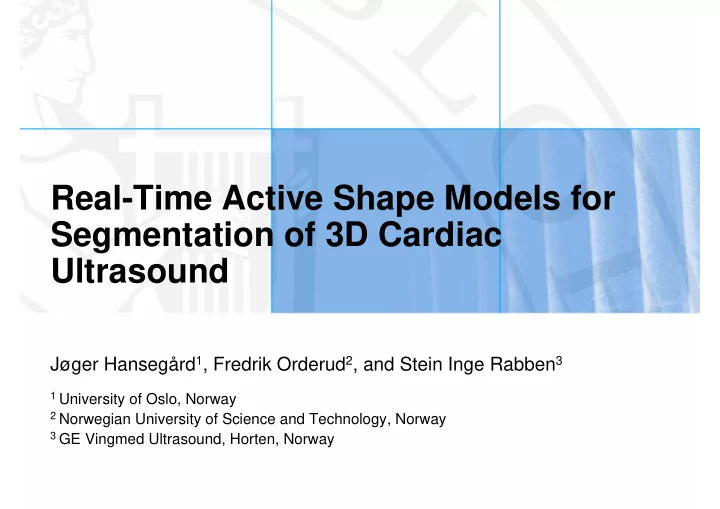

Real-Time Active Shape Models for Segmentation of 3D Cardiac Ultrasound Jøger Hansegård 1 , Fredrik Orderud 2 , and Stein Inge Rabben 3 1 University of Oslo, Norway 2 Norwegian University of Science and Technology, Norway 3 GE Vingmed Ultrasound, Horten, Norway
Background and aim Background • Rapid global function • Intraoperative monitoring/ trending • Lack of real-time 3D segmentation methods Aim • Real-time 3D segmentation of left ventricle. Jøger Hansegård, Dept. of Informatics
3D Ultrasound data Characteristics • Displayed in real-time • 15-20 frames/sec • ECG-gating over 4 heartbeats Challenges: • Shadows, drop-outs, noise, speckle, reverberations. Jøger Hansegård, Dept. of Informatics
Previous work Traditional deformable models • Level sets, simplex mesh, FEM, statistical shape models • May require hundreds of iterations • Not suitable for real-time operation Kalman filter based methods • Single iteration - Ideal for real-time operation • Blake, Jacob, Comaniciu: 2D contours • Orderud: 3D rigid ellipsoid model – Fast, not physiologically realistic. • Orderud: 3D deformable spline model – Better regional accuracy, not limited to physiologically realistic shapes. Jøger Hansegård, Dept. of Informatics
Kalman filter based segmentation • Parametric deformable model, e.g. spline model, active shape model • Segmentation as estimation – Sequential state estimation techniques to track the model parameters – Computational efficient algorithms, e.g. Kalman- filter Jøger Hansegård, Dept. of Informatics
Processing overview ^ x,P - For each frame: x,P predict correct • Predict contour shape and measure position, using a kinematic - x,P H T R -1 v, model for each model H T R -1 H parameter • Measure edges in proximity of predicted surface • Use measurements to Three-step process for each frame. correct prediction Di r ect cl os ed f or m s ol ut i on i ns t ead of i t er at i ve r ef i nem ent ! Jøger Hansegård, Dept. of Informatics
Deformable model (1/2) 3D active shape model (ASM) • Assume deformation in normal direction n i to reduce Linear model consisting of: computational cost to 1/3. • Average shape • Deformation modes A i Built by PCA on training set Shape controlled by state x l 20 states explains 98% of variation in training set (31 patients). Jøger Hansegård, Dept. of Informatics
Deformable model (2/2) Local transformation Global transformations Deformation + Interpolation Rotation + Scaling + Position Combined state vector Jøger Hansegård, Dept. of Informatics
Local edge detection n Measured • Perform edge detection in p obs surface normal direction of surface. • Use normal displacement n p from predicted to measured Predicted p surface surface p obs • Detected edge maximizes intensity transition Jøger Hansegård, Dept. of Informatics
Experiments Setup Initialization • Average shape/fixed Reference: Manually verified position. surfaces from off-line semi- automated tool, (N=21) • Track for a couple of cycles to get lock. ASM trained on separate population (N=31) Key parameters • End diastolic volume (EDV) Machine: 2.16 GHz Intel Core 2 Duo. • End systolic volume (ESV) • Ejection fraction (EF) Jøger Hansegård, Dept. of Informatics
Initialization Jøger Hansegård, Dept. of Informatics
Examples (1/2) Jøger Hansegård, Dept. of Informatics
Examples (2/2) Jøger Hansegård, Dept. of Informatics
Results 2.2 ±1.1 mm point-to-surface error Good agreement in volumes and EF 22% CPU load (video rate) Jøger Hansegård, Dept. of Informatics
Discussion • Real-time • Manual correction difficult • Physiologically realistic • Missing data problematic surfaces – Narrow imaging sector • No user input – Drop-outs • Robust to ultrasound artifacts Jøger Hansegård, Dept. of Informatics
Conclusion We have developed a fully automatic algorithm for real-time segmentation of the left ventricle in 3D cardiac ultrasound. Initial evaluation is promising. A larger scale trial is required to evaluate clinical potential. Jøger Hansegård, Dept. of Informatics
THANKS! Jøger Hansegård, Dept. of Informatics
Measurement sequence 1. Create contour template. 2. Calculate deformed contour, and associated Jacobi matrix based on predicted Measure: Deform: p 0 ,n 0 p, n v, r state. D(p 0 ,X) - X 3. Measure normal n T J x D(...) h displacements based on deformed contour. Jøger Hansegård, Dept. of Informatics
Kalman Filter Implementation Using an extended Kalman Measurement update in filter for tracking information space • Assumption of independent • Enables usage of nonlinear measurements allow deformation models. efficient implementation • Linearizes model around • Create information-vector predicted state. and -matrix from Kinematic prediction measurements • Augment state vector to • Use information filter contain state from last two formulation of Kalman filter for measurement update. successive frames. • Models motion, in addition to state/position Jøger Hansegård, Dept. of Informatics
Examples (3/2) Jøger Hansegård, Dept. of Informatics
Recommend
More recommend